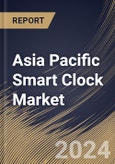The smart clock is no longer an isolated device but a key player in the interconnected web of smart home devices and ecosystems. The trend of seamless integration with other smart devices, including smartphones, wearables, and home automation systems, is reshaping the landscape of the market. This integration not only enhances functionality but also fosters a cohesive user experience. As consumer demands evolve, the industry has witnessed the rise of hybrid smartwatches that blend the elegance of traditional timepieces with the intelligence of smart technology. These devices appeal to those who desire the classic aesthetics of a wristwatch while benefiting from select smart features, reflecting a nuanced approach to the convergence of fashion and technology.
With environmental consciousness gaining prominence, there is a discernible trend toward sustainable and eco-friendly designs in the market. Manufacturers are exploring materials and production processes that minimize environmental impact, responding to the growing consumer preference for products aligned with sustainability goals. The pace of technological innovation is a primary driver of the market. Advancements in sensor technology, battery efficiency, and connectivity protocols continually enhance the capabilities of these, enabling the integration of more sophisticated features and improving overall performance.
In Asia, nations like China, Japan, South Korea, and India have rapidly increased technology adoption. According to the 14th Five-Year Plan (2021-2025), China aims to increase its urbanization rate to 65%. An increase in affluent individuals and households often accompanies growing urbanization. This demographic tends to have the purchasing power to invest in smart home technologies. Urbanization often leads to busier lifestyles, with individuals in urban areas having demanding schedules. Smart clocks, offering features beyond traditional timekeeping, cater to individuals seeking convenience, productivity, and time management solutions. Due to the aforementioned factors the market growth will drive in this region.
The China market dominated the Asia Pacific Smart Clock Market by Country in 2022 and would continue to be a dominant market till 2030; thereby, achieving a market value of $201.5 million by 2030. The Japan market is registering a CAGR of 17.3% during (2023 - 2030). Additionally, The India market would showcase a CAGR of 18.9% during (2023 - 2030).
Based on Distribution Channel, the market is segmented into Online, Specialty Stores, and Others. Based on countries, the market is segmented into China, Japan, India, South Korea, Singapore, Malaysia, and Rest of Asia Pacific.
List of Key Companies Profiled
- Amazon.com, Inc.
- SDI Technologies, Inc.
- Lenovo Group Limited
- Emerson Electric Co.
- Sony Corporation
- Koninklijke Philips N.V.
- Panasonic Holdings Corporation
- Samsung Electronics Co., Ltd. (Samsung Group)
- Google LLC (Alphabet Inc.)
- Bose Corporation
Market Report Segmentation
By Distribution Channel (Volume, Thousand Units, USD Billion, 2019-2030)- Online
- Specialty Stores
- Others
- China
- Japan
- India
- South Korea
- Singapore
- Malaysia
- Rest of Asia Pacific
Table of Contents
Companies Mentioned
- Amazon.com, Inc.
- SDI Technologies, Inc.
- Lenovo Group Limited
- Emerson Electric Co.
- Sony Corporation
- Koninklijke Philips N.V.
- Panasonic Holdings Corporation
- Samsung Electronics Co., Ltd. (Samsung Group)
- Google LLC (Alphabet Inc.)
- Bose Corporation








